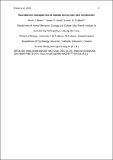Reproductive consequences of material use in avian nest construction
Abstract
Birds’ nests represent a rich behavioural ‘fingerprint’, comprising several important decisions—not the least of which is the selection of appropriate material. Material selection in nest-building birds is thought to reflect, in part, builder-birds’ use of the ‘best’ material—in terms of physical properties (e.g., rigidity)—refined across generations. There is, however, little experimental evidence to link the physical properties of nest material to both birds’ nest building and breeding performance. We examined individual-level material-use consequences for breeding zebra finches by manipulating the kind of material available to laboratory-housed pairs: stiff or flexible same-length string. We show that higher fledgling numbers were related to (i) fewer pieces used in nest construction by stiff-string builders; and conversely, (ii) more pieces used in nest construction by flexible-string builders. Together, these data suggest that physical differences in nest material can affect avian reproduction (here, the trade-off between nest-construction investment and breeding success), highlighting the adaptive significance of nest-building birds’ material selectivity.
Citation
Breen , A J , Healy , S D & Guillette , L M 2021 , ' Reproductive consequences of material use in avian nest construction ' , Behavioural Processes , vol. 193 , 104507 . https://doi.org/10.1016/j.beproc.2021.104507
Publication
Behavioural Processes
Status
Peer reviewed
ISSN
0376-6357Type
Journal article
Description
This study was funded by the School of Biology and a St. Leonard’s College Scholarship at the University of St. Andrews, UK (both to A.J.B.), and by the Biotechnology and Biological Sciences Research Council (Anniversary Future Leader Fellowship to L.M.G.; grant number: BBSRC – BB/M013944/1).Collections
Items in the St Andrews Research Repository are protected by copyright, with all rights reserved, unless otherwise indicated.

